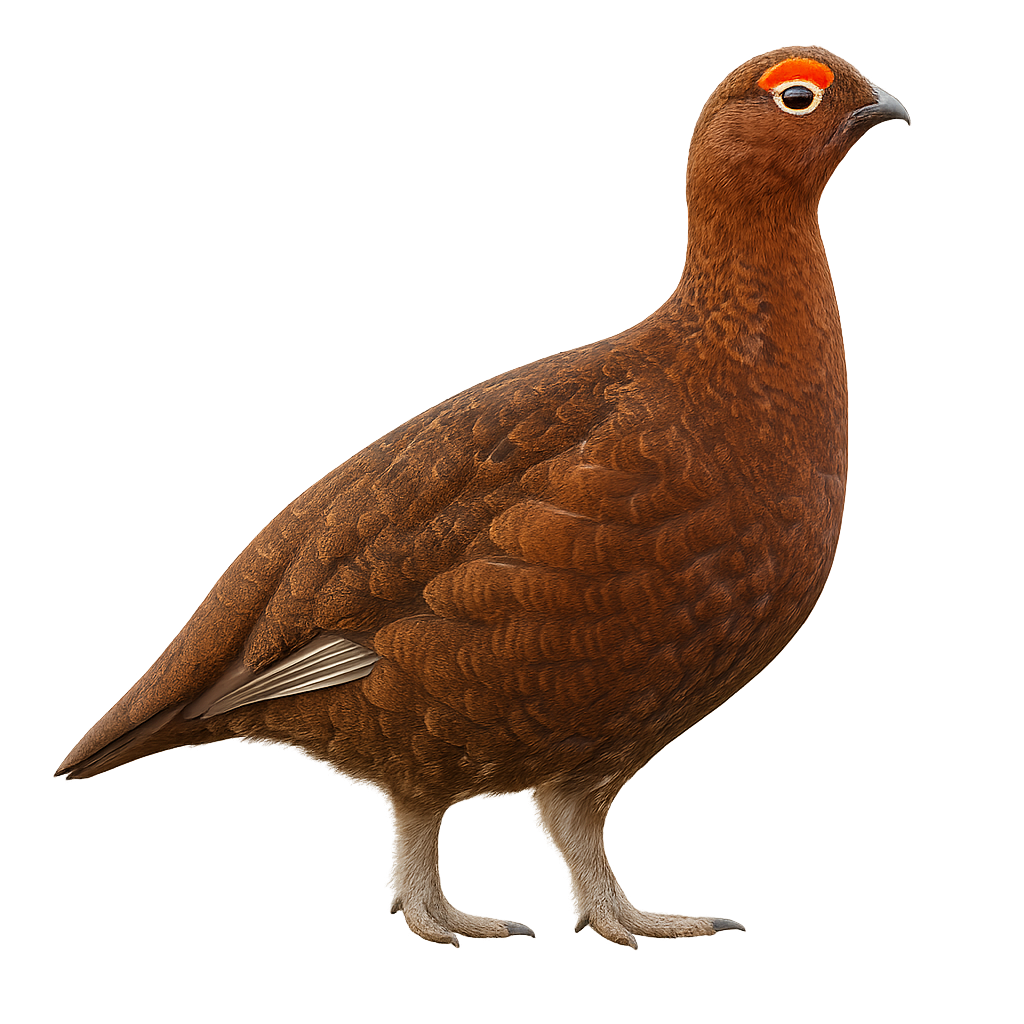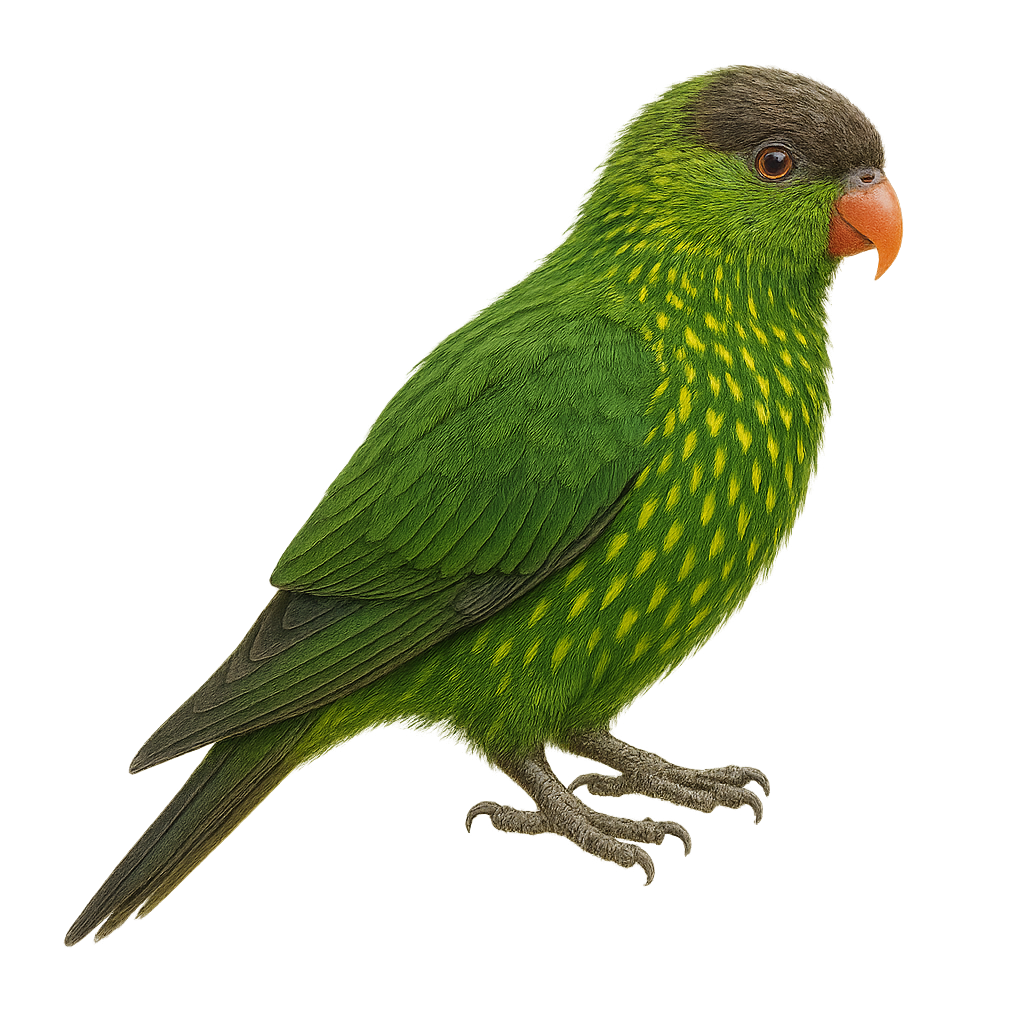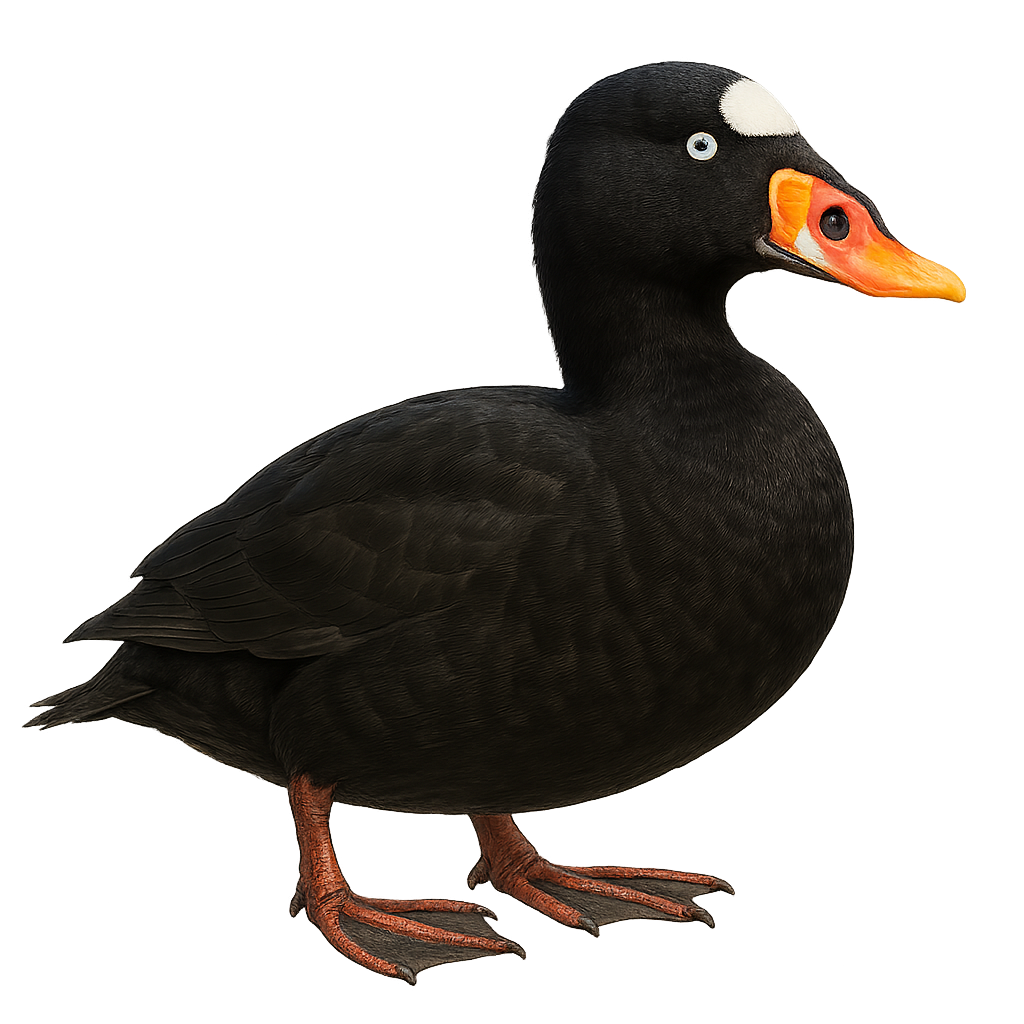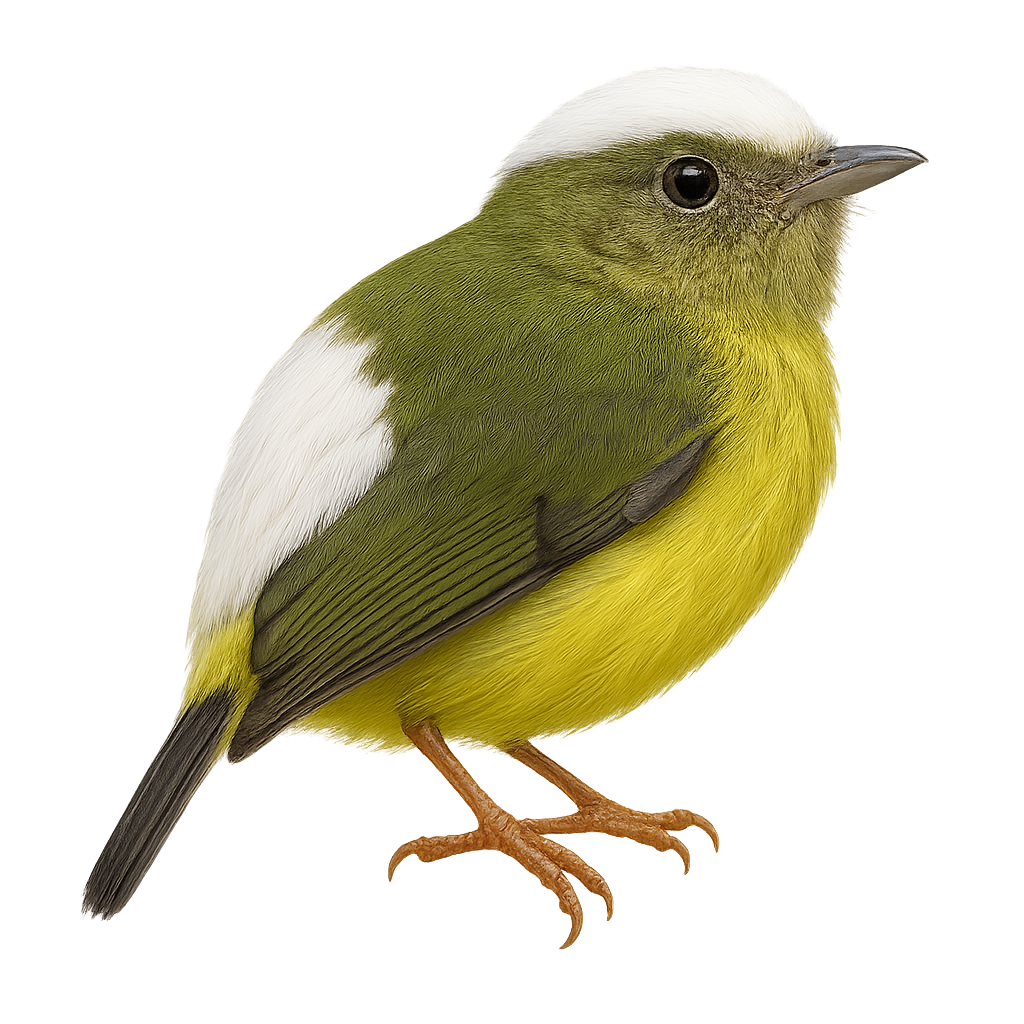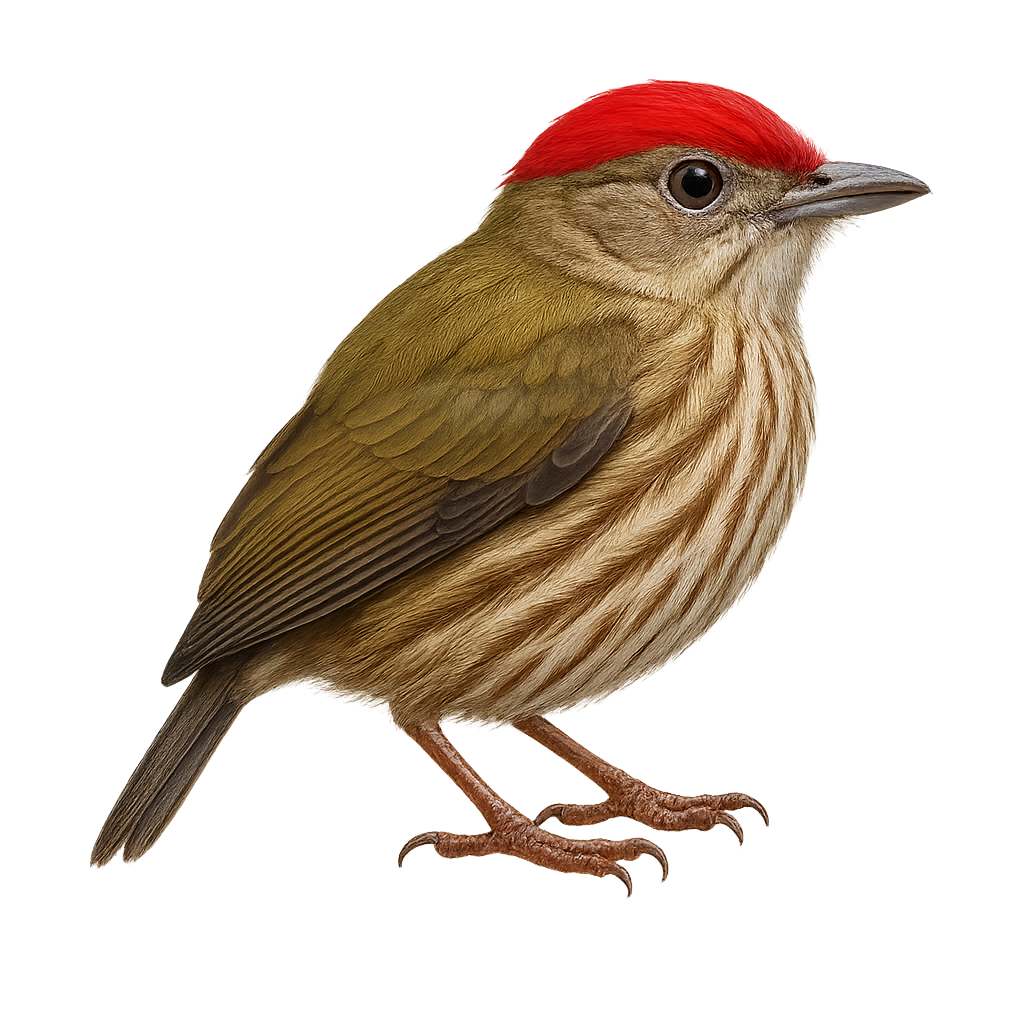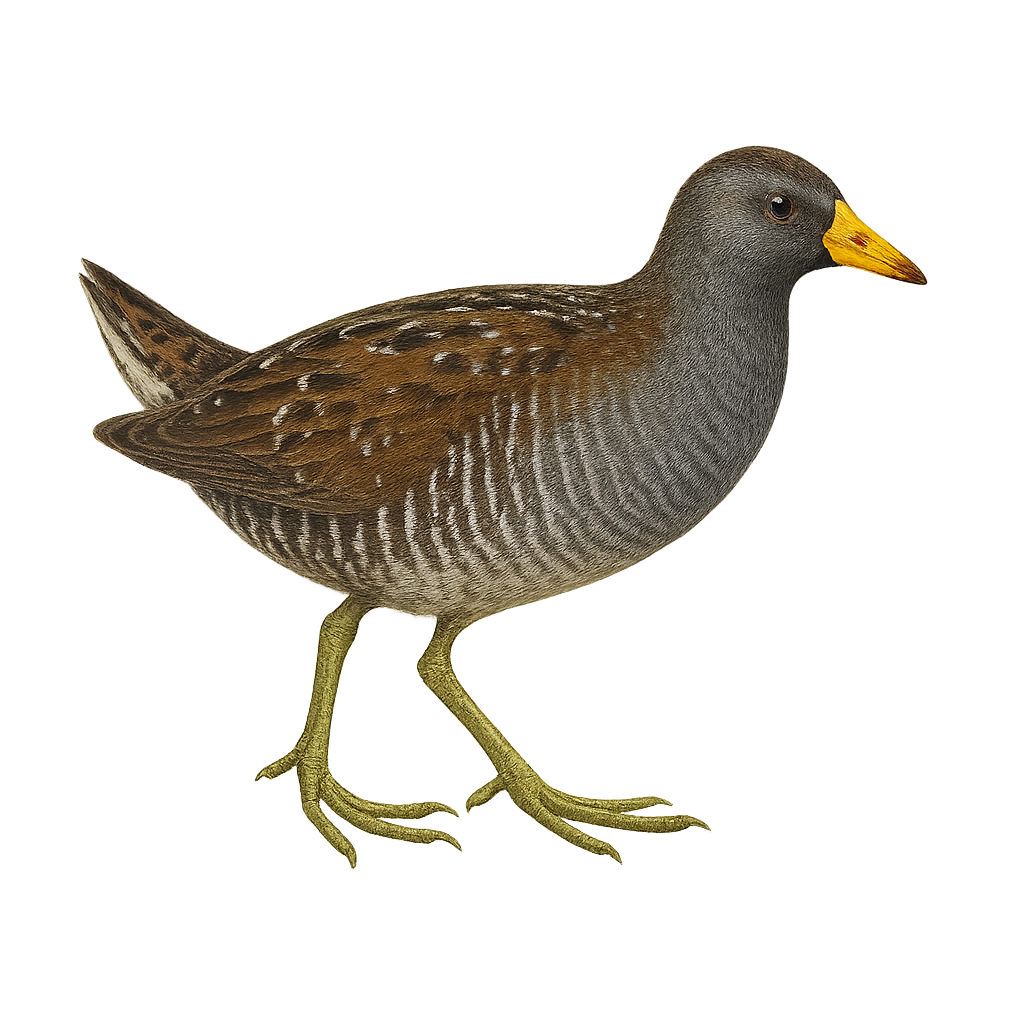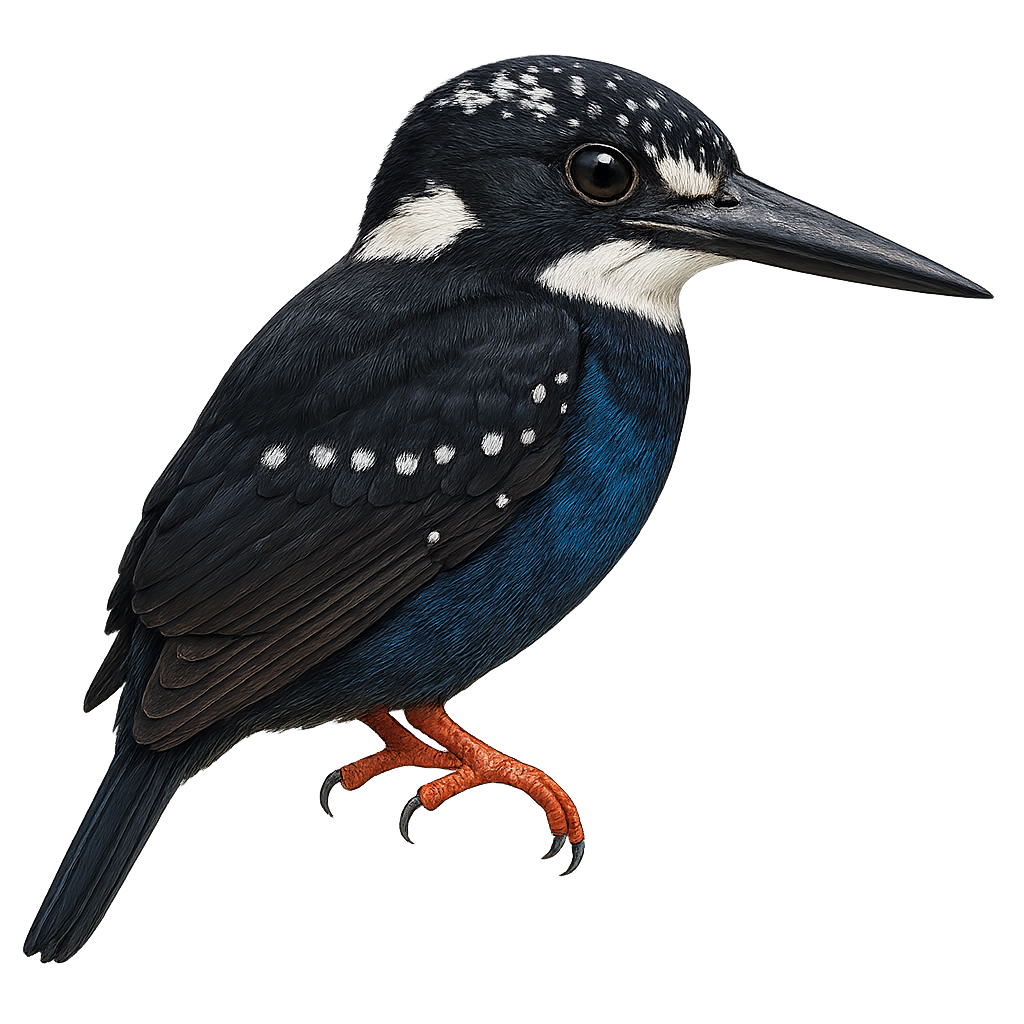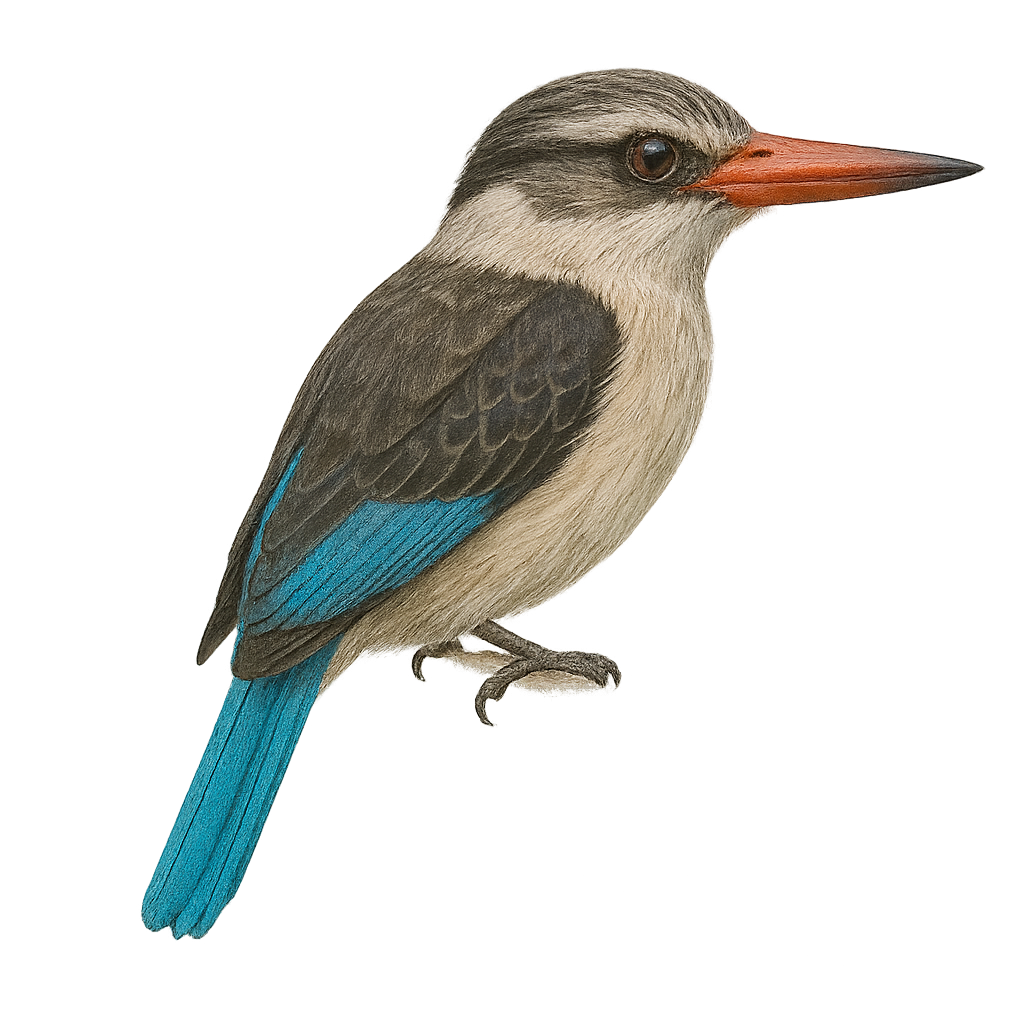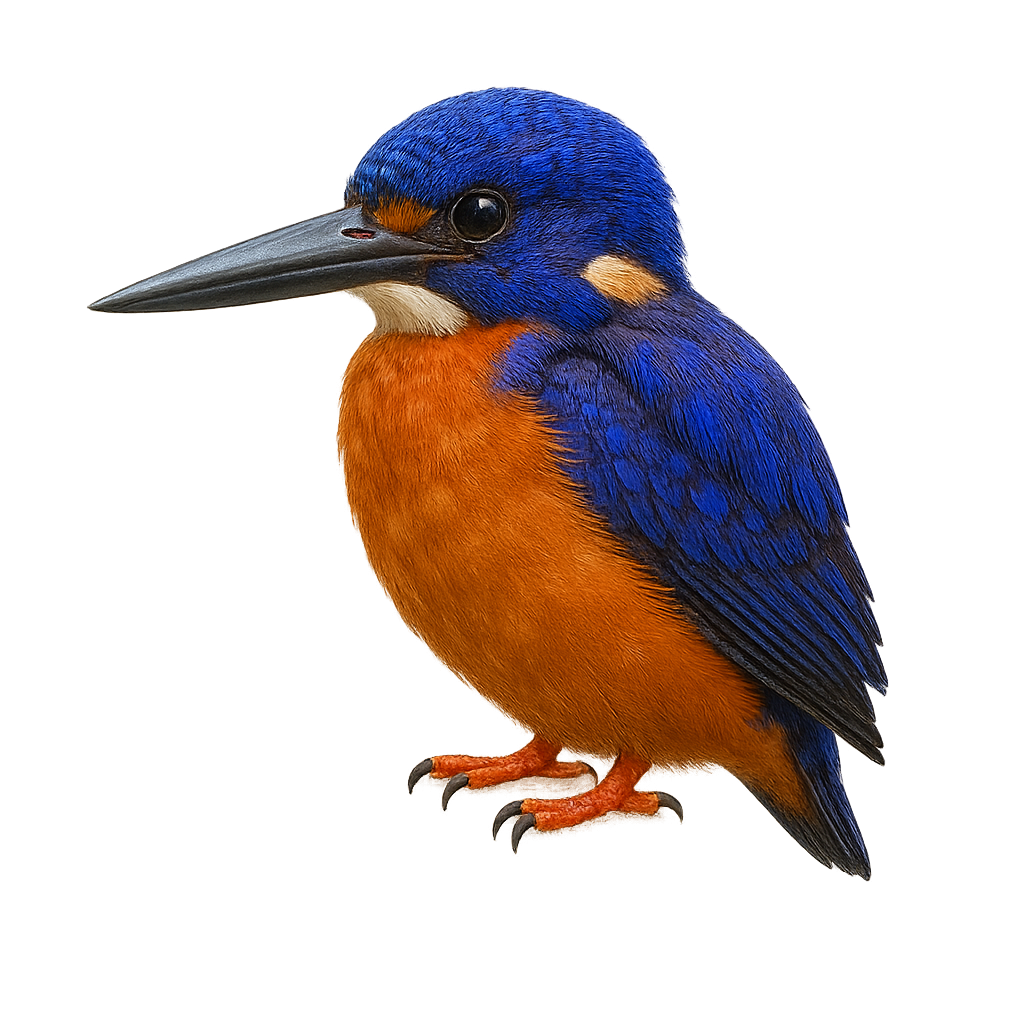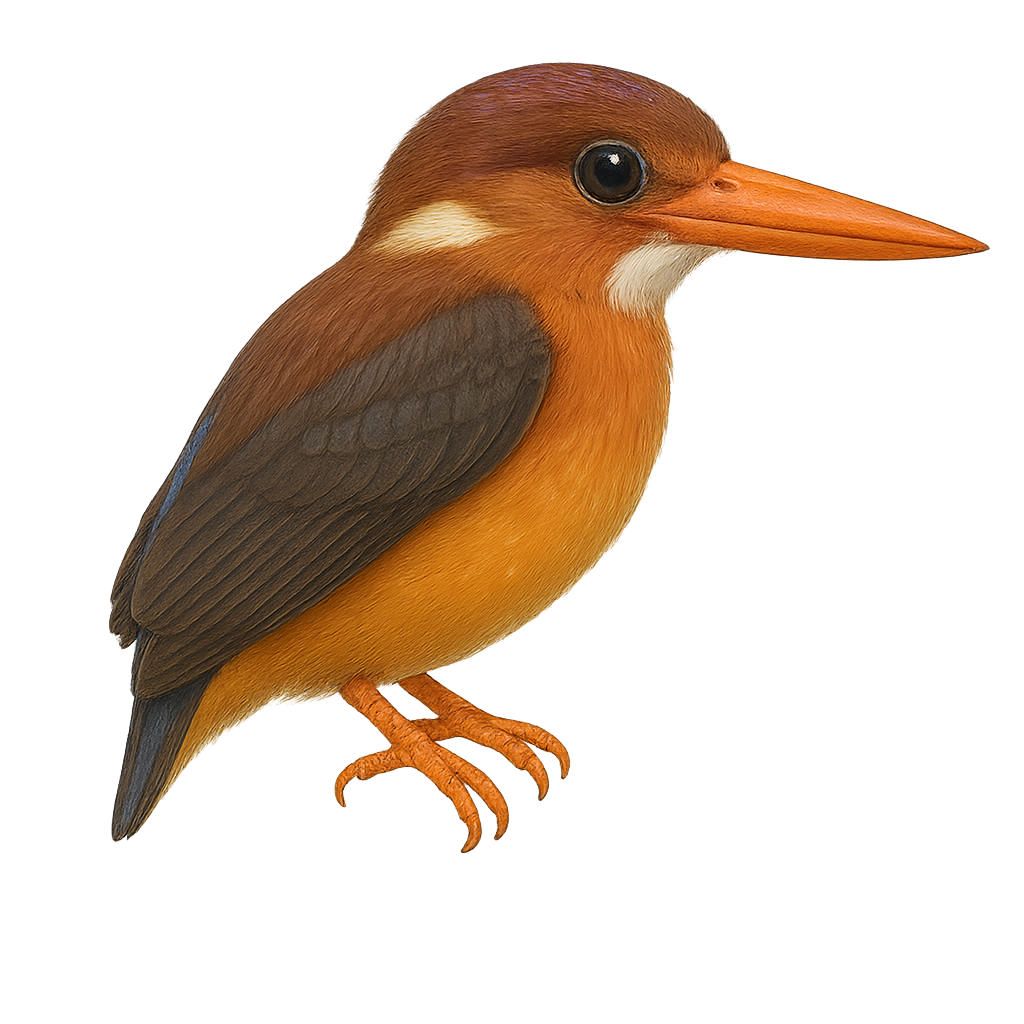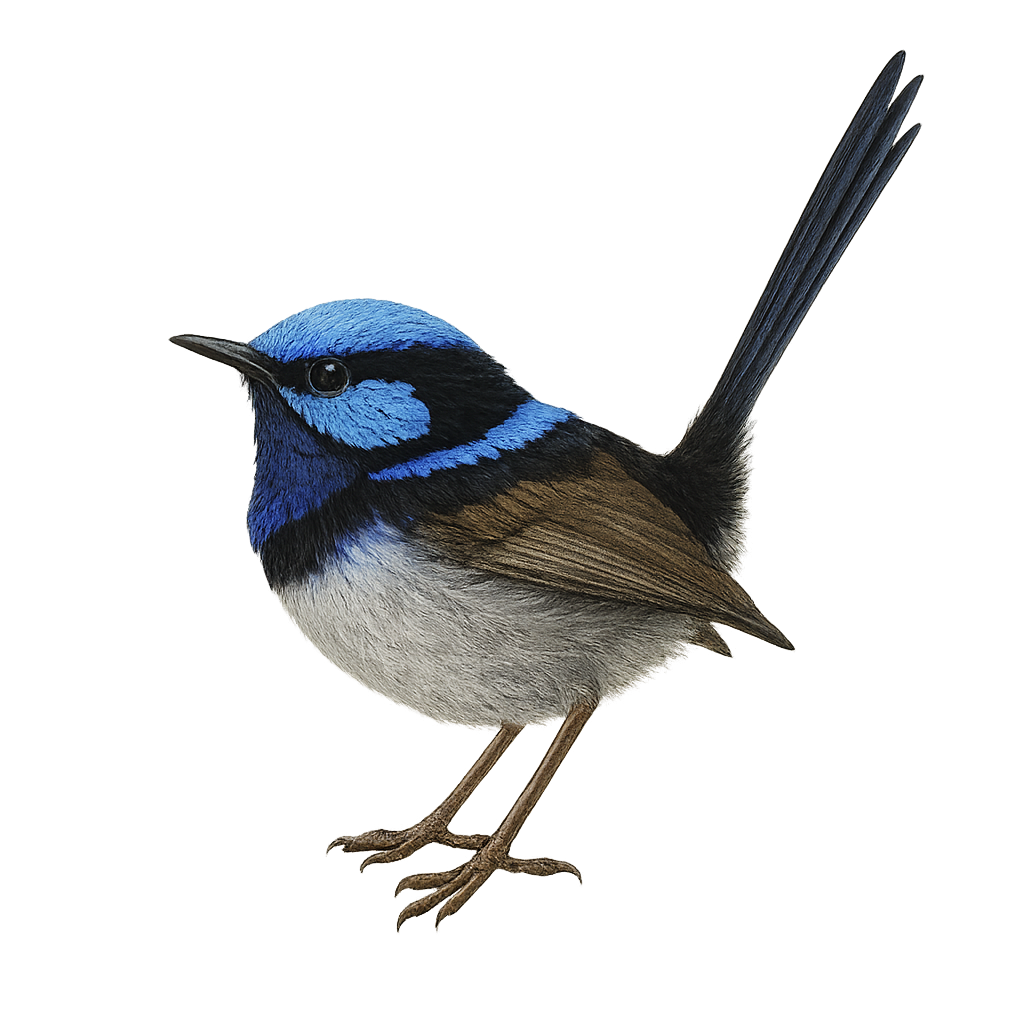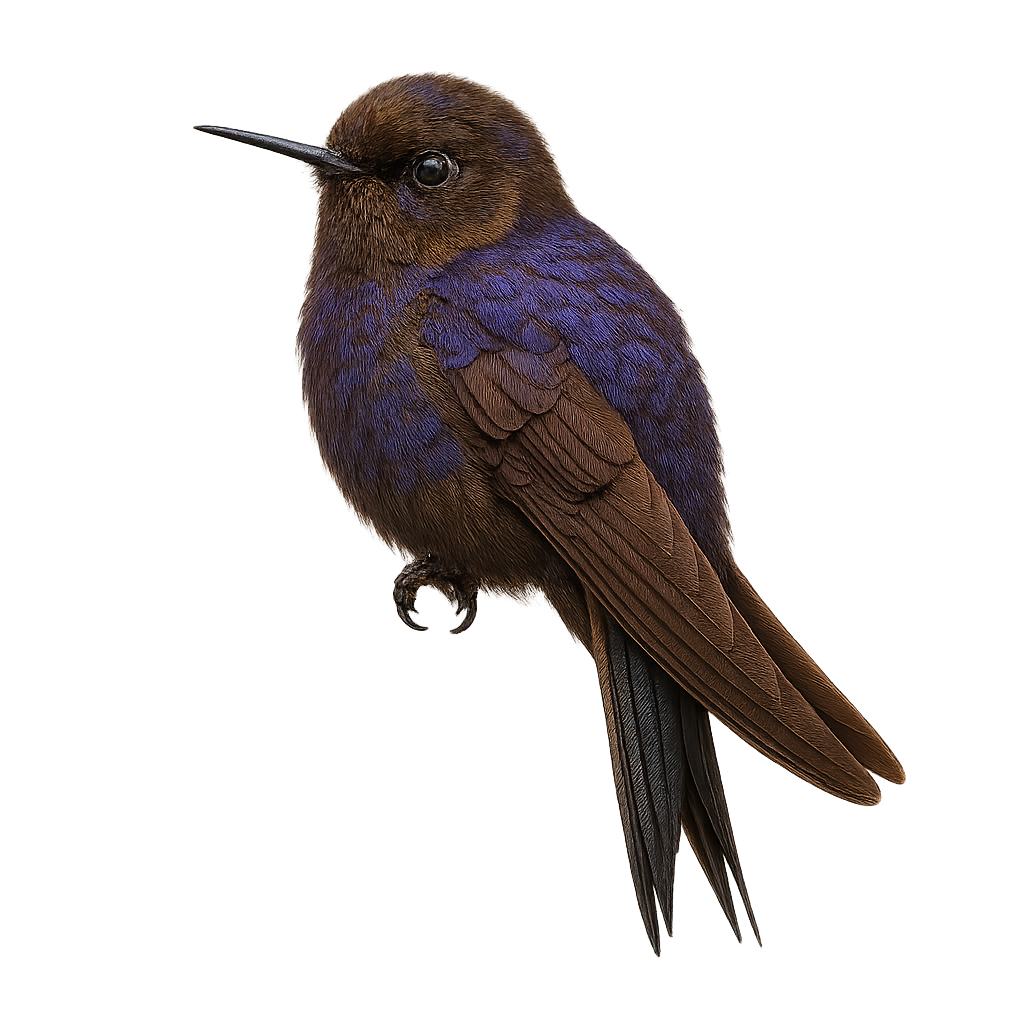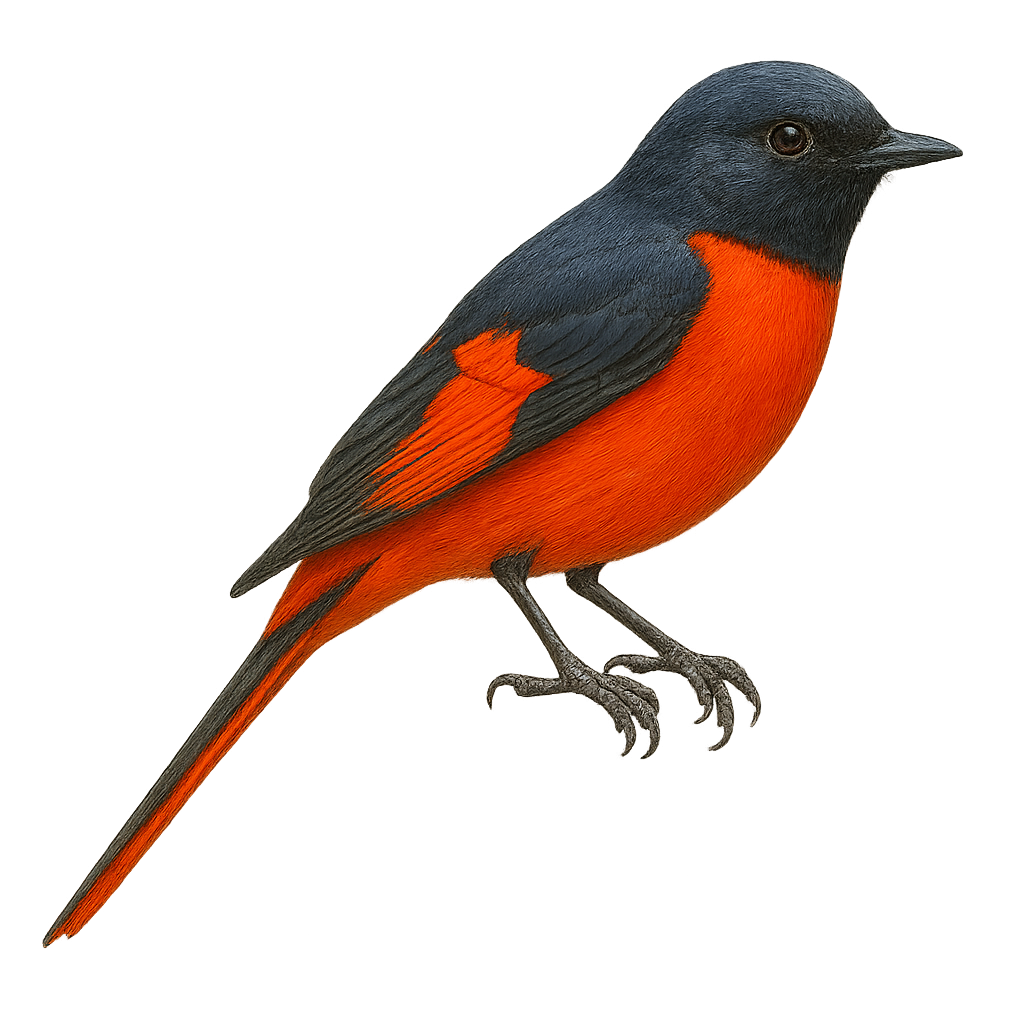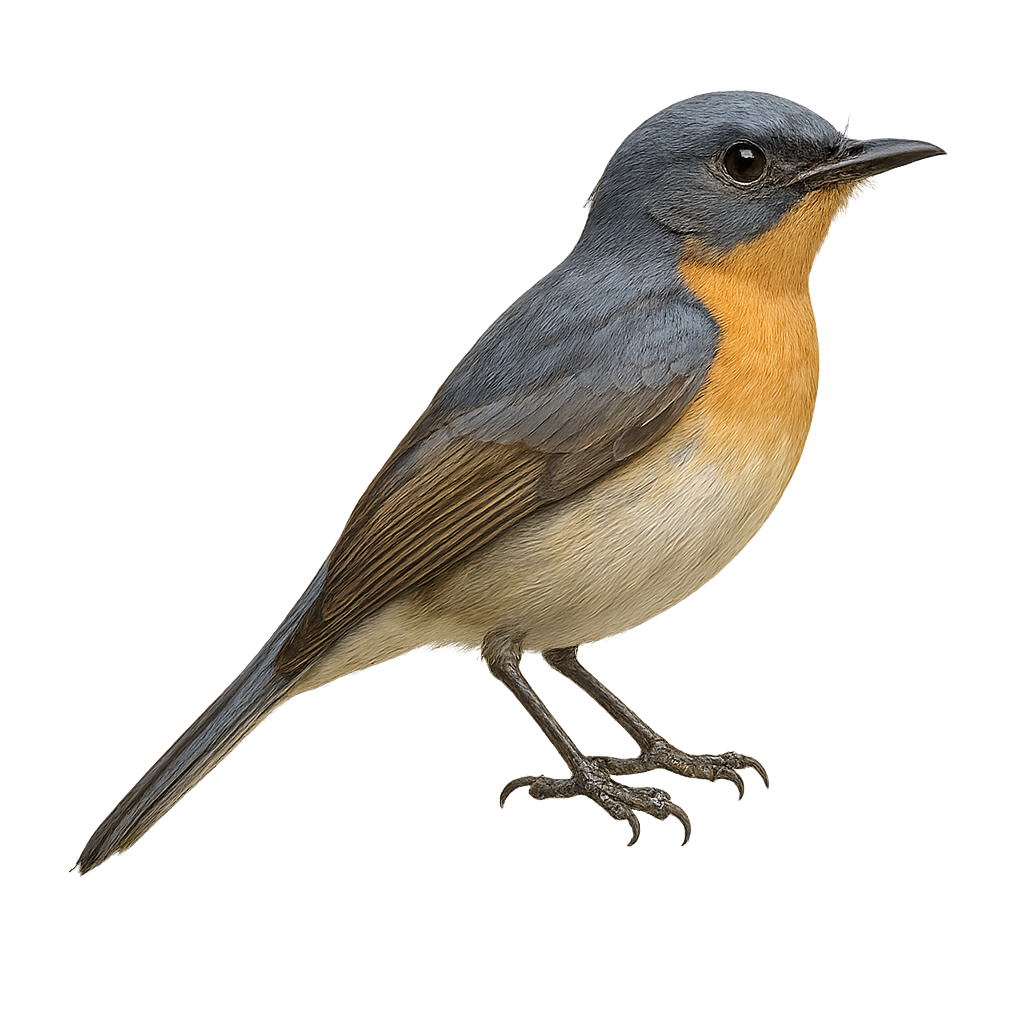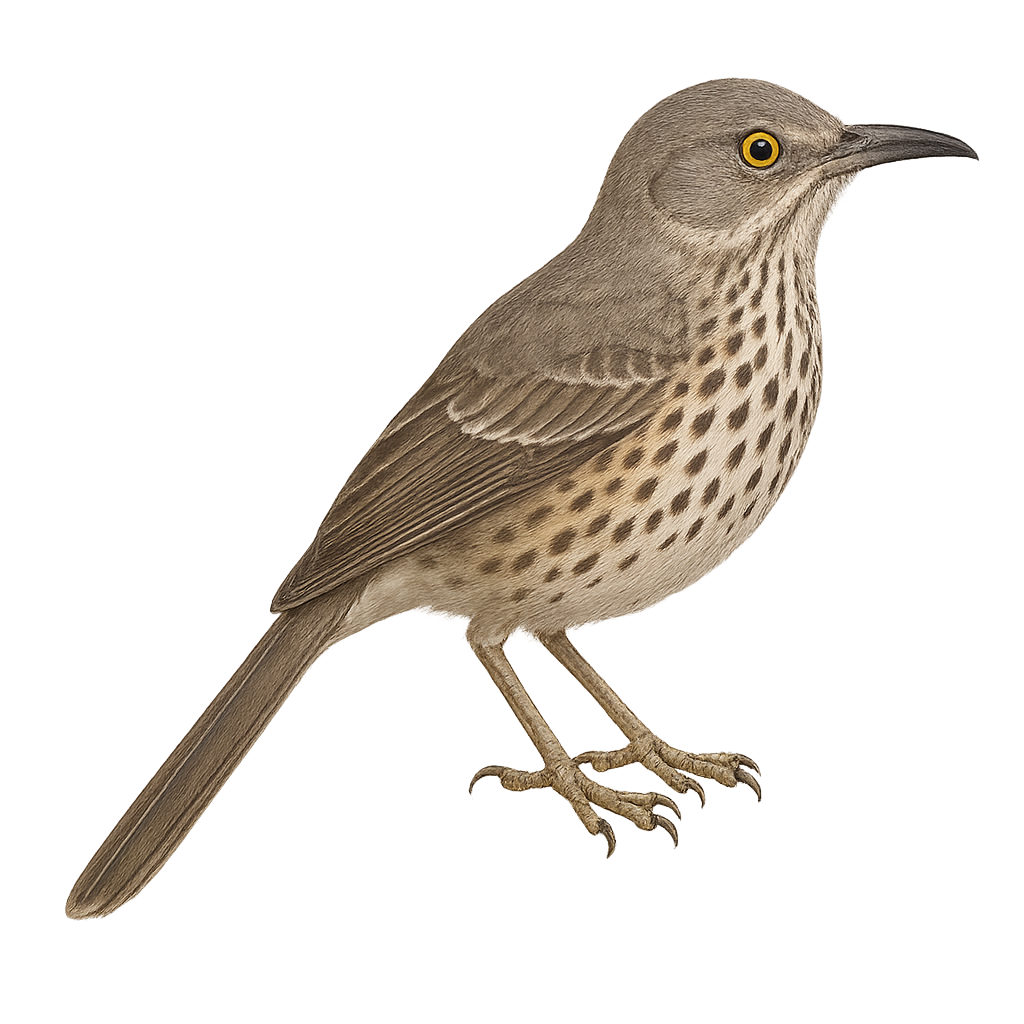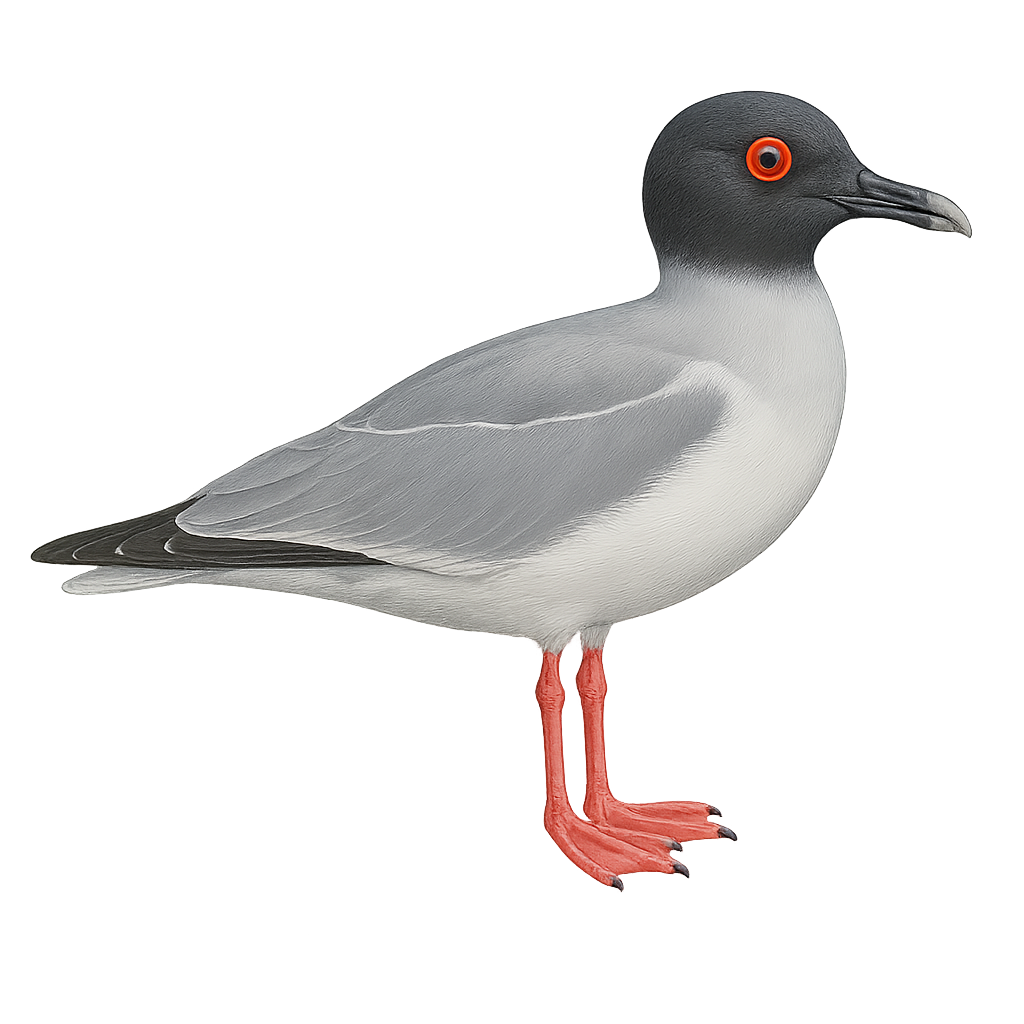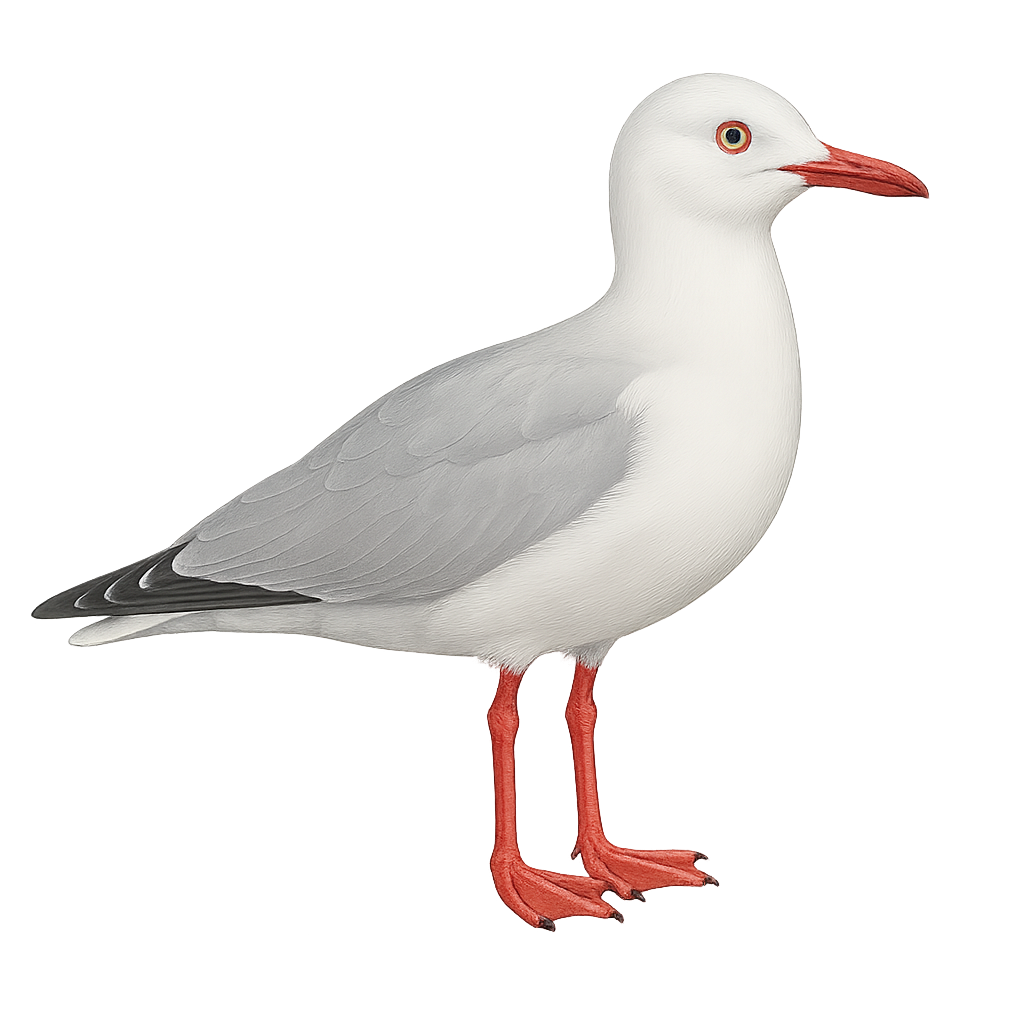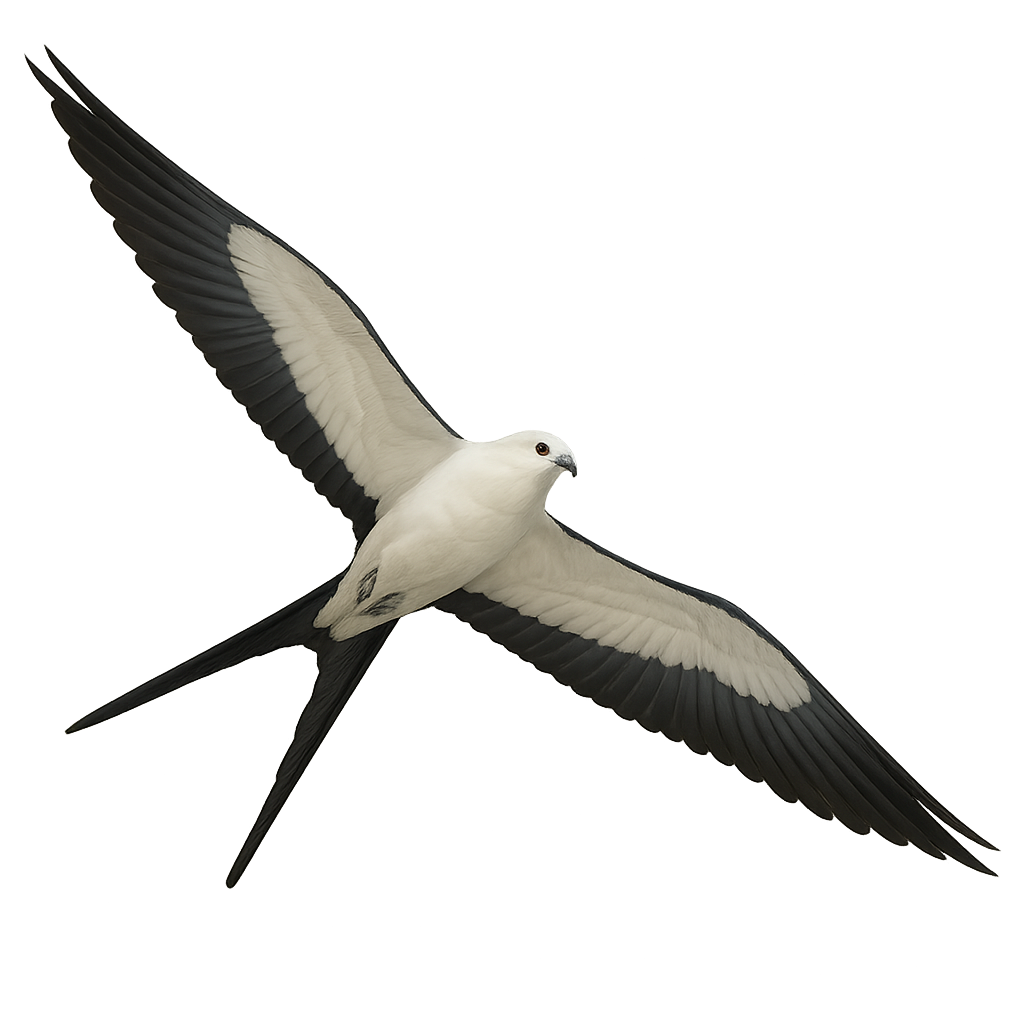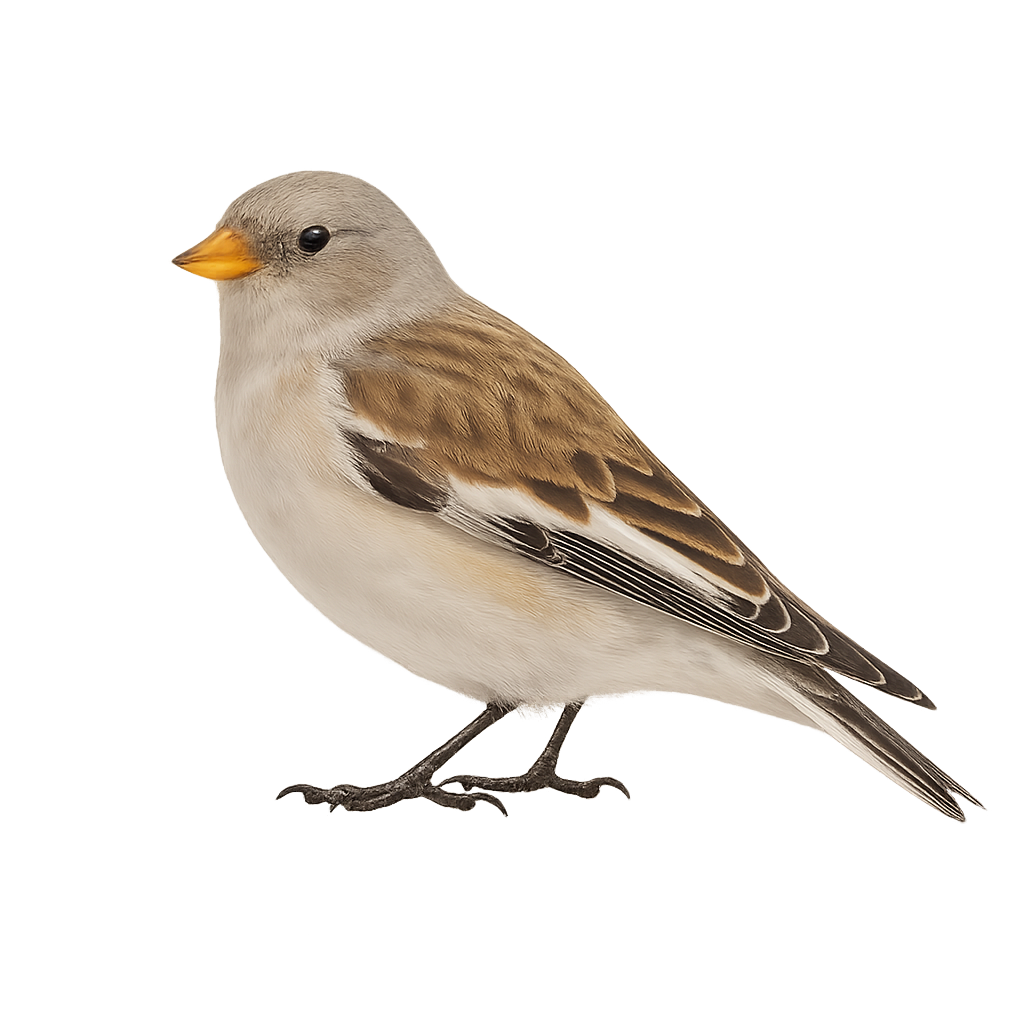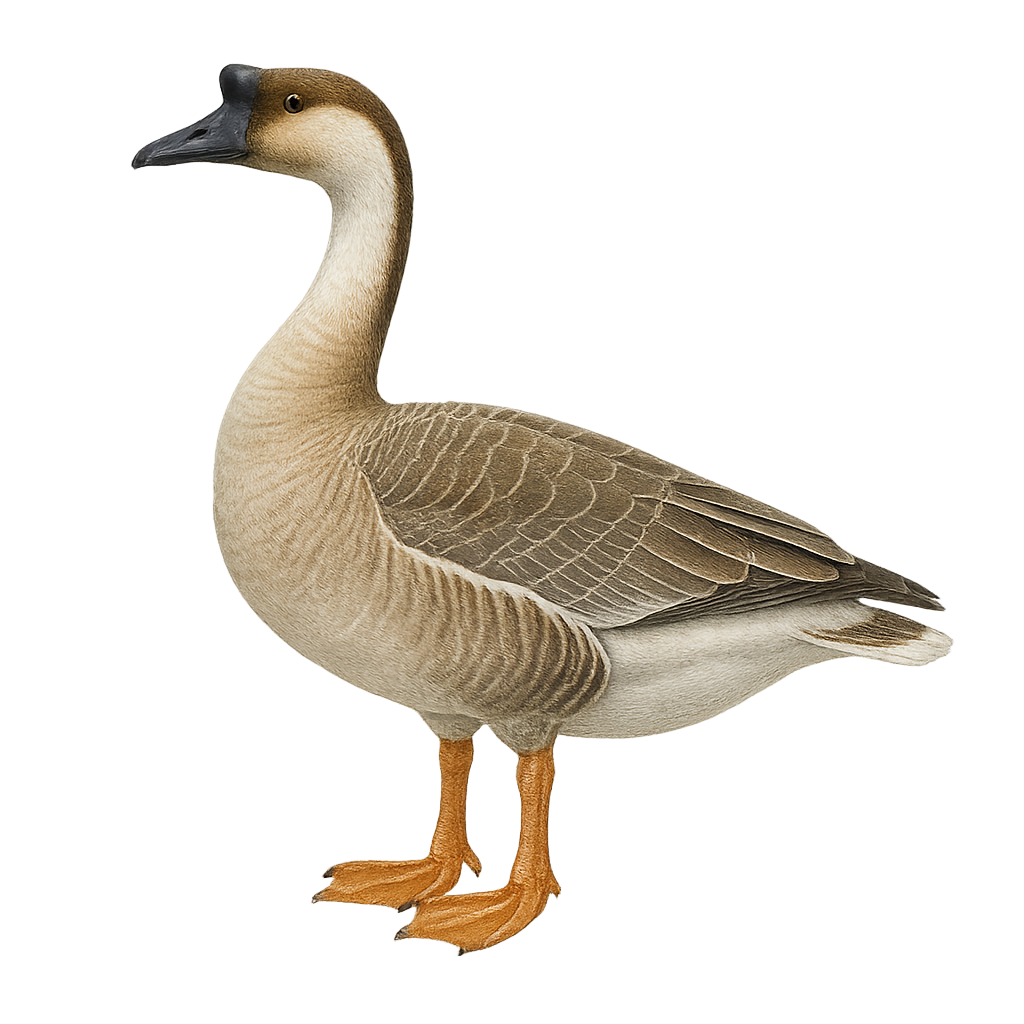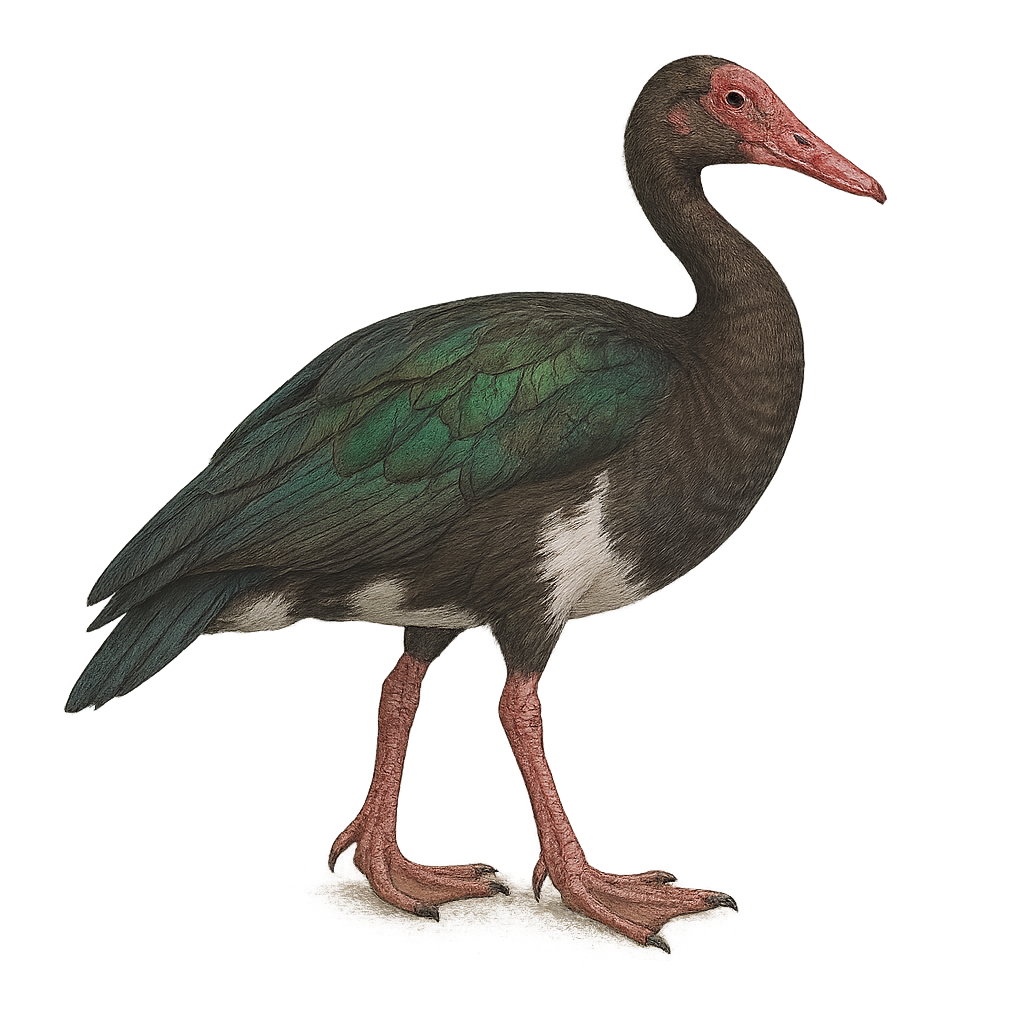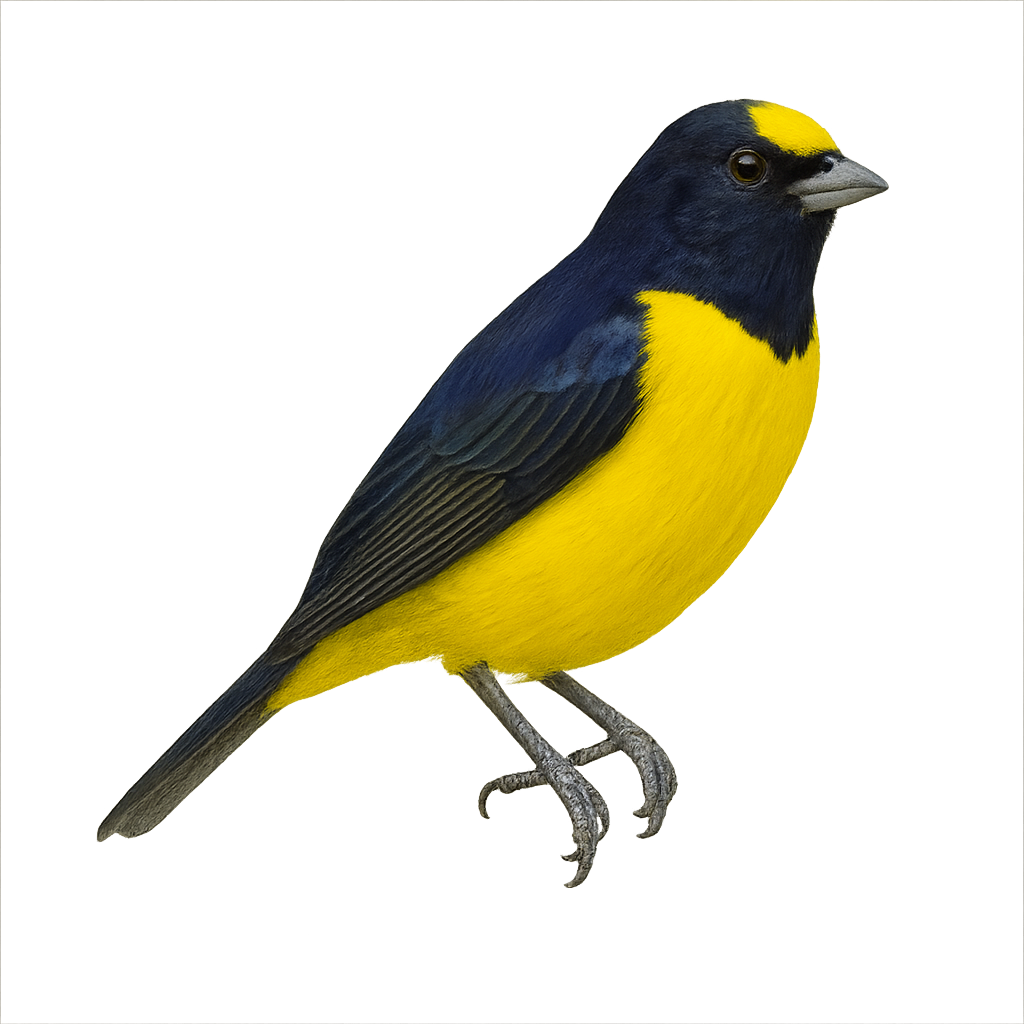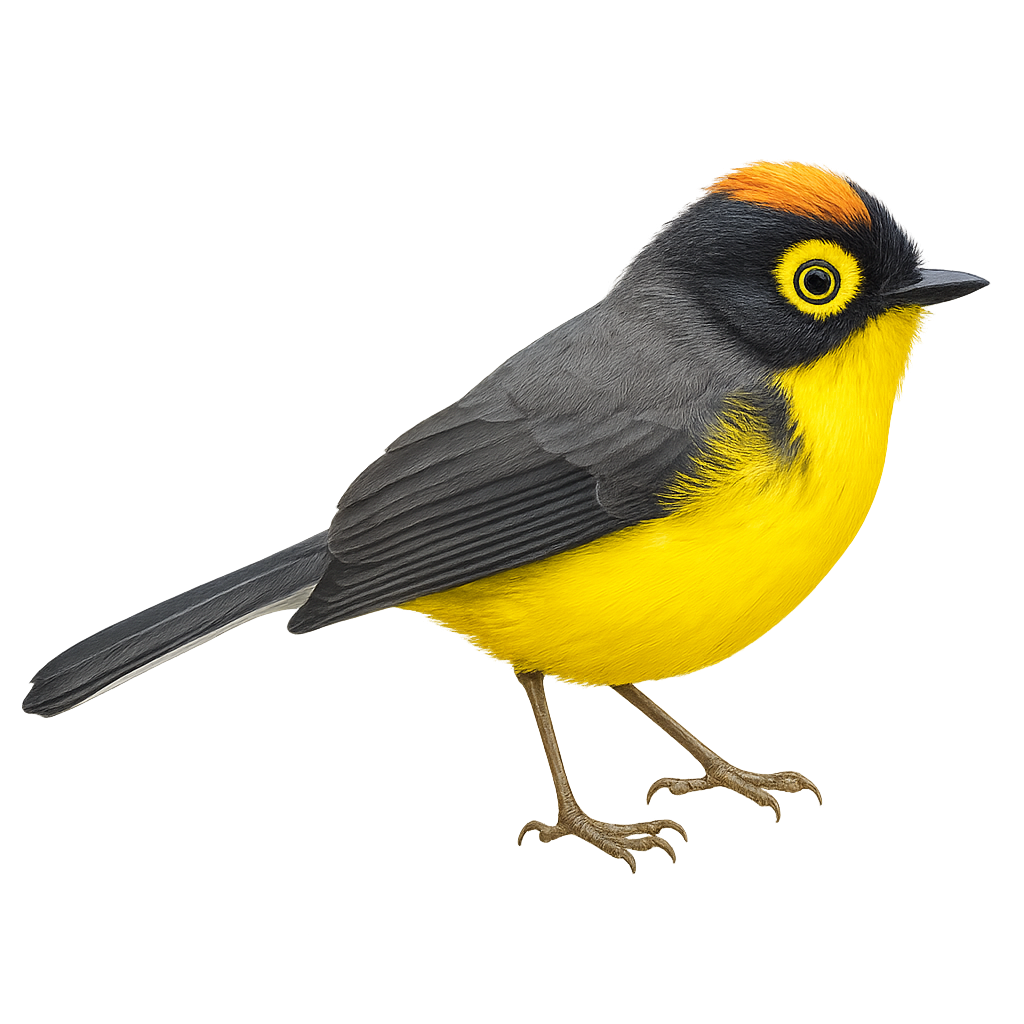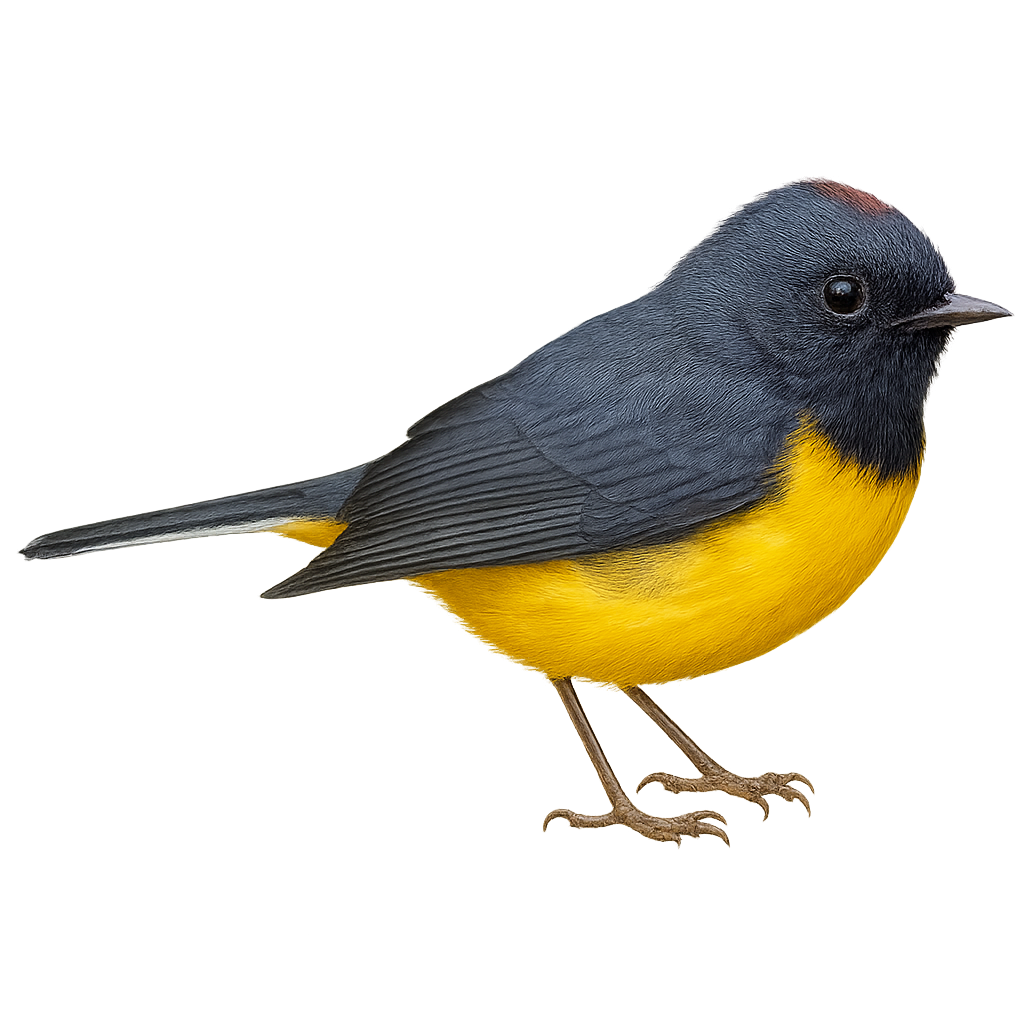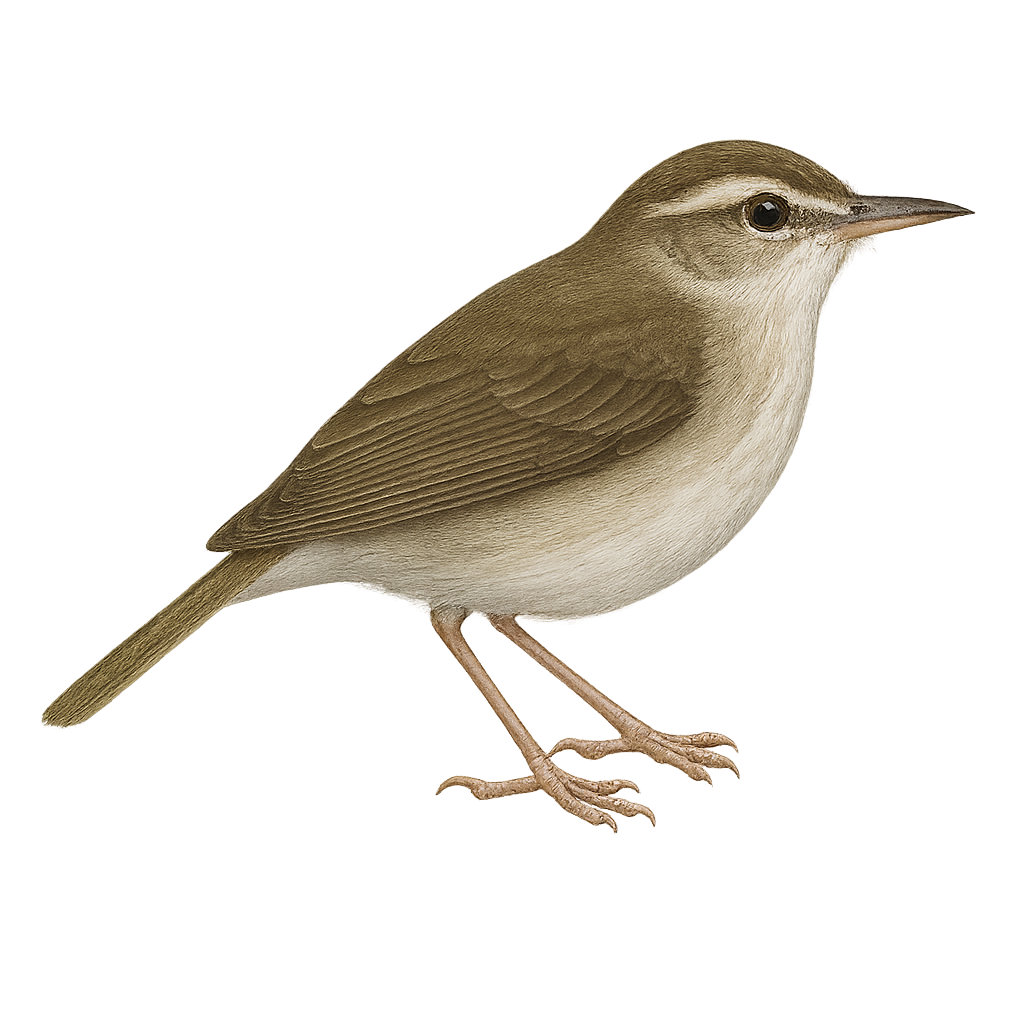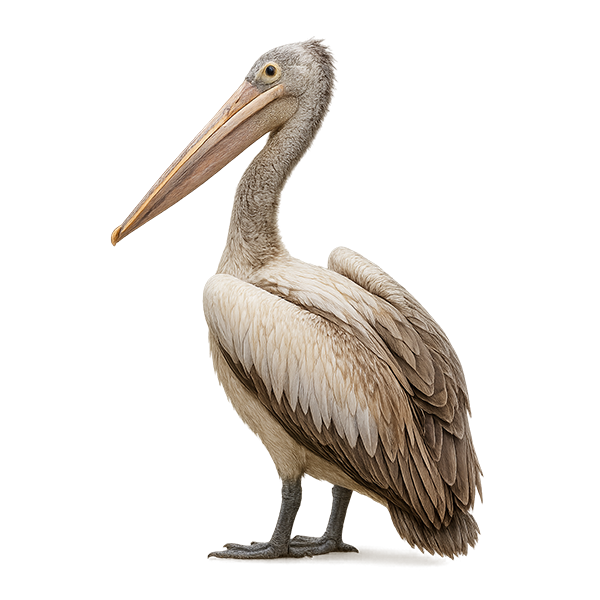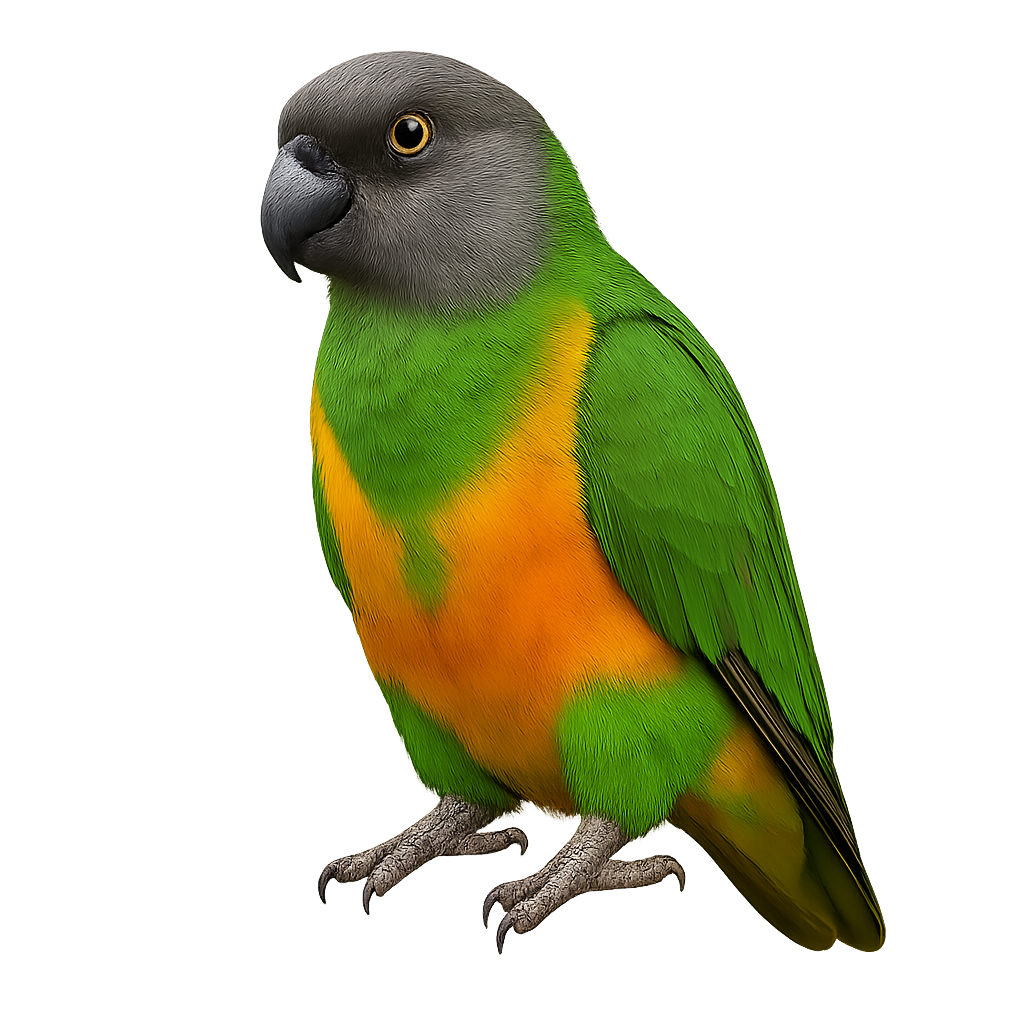The Scottish Ptarmigan, or Lagopus lagopus scotica, is a subspecies of the Willow Ptarmigan, specifically found in the mountains of Scotland. It measures about 30 to 35 cm in length and weighs between 300 and 450 g. Its plumage changes with the seasons: in winter, it is entirely white, allowing it to blend perfectly into the snow, while in summer, it has a brown-red spotted plumage that makes it blend into the Scottish moorlands. The Scottish Ptarmigan inhabits the highlands, particularly in the northern mountains of Scotland, where it primarily feeds on plants, berries, seeds, and young shoots. Although it is a bird difficult to spot due to its excellent camouflage, it remains vulnerable to climate change and the loss of its natural habitat. The Scottish Ptarmigan is also threatened by predation from foxes and mustelids and by human activities, including tourism and land management.
The Striated Lorikeet, Charmosyna multistriata, is a small, colorful parrot native to the tropical forests of New Guinea. This lorikeet is distinguished by its bright green plumage adorned with fine red and yellow stripes on its belly, and a vivid orange beak. It measures about 18 cm in length and weighs between 30 and 40 grams. Its natural habitat includes lowland and mid-altitude rainforests, where it primarily feeds on nectar, pollen, and fruits. Although its conservation status is concerning due to deforestation, it remains relatively common in some areas. The Striated Lorikeet is known for its sociability and tendency to move in small, noisy groups.
The Surf Scoter, Melanitta perspicillata, is a medium-sized diving duck, easily identifiable by its black plumage and distinctive white forehead in males. Females have a more subdued brown plumage. This duck primarily feeds on mollusks, crustaceans, and small fish, which it captures by diving underwater. It is mainly found along the North American coasts but migrates southward in winter. The Surf Scoter is often seen in large flocks, making it a spectacular sight in flight. Although relatively common, it is sometimes threatened by marine pollution and habitat loss.
The Snow-capped Manakin is a small, colorful bird primarily found in the tropical rainforests of South America, particularly in Brazil. This passerine is easily recognizable by its striking black plumage contrasted with a bright white cap in males, while females display more subdued olive-green tones. Known for their spectacular courtship displays, males perform intricate dances to attract females. These birds are often seen in small groups and primarily feed on fruits and insects. Their habitat is threatened by deforestation, but they are currently classified as Least Concern by the IUCN.
The Striped Manakin, Machaeropterus striolatus, is a small, colorful bird found in the tropical forests of South America. It is easily recognizable by its vibrant plumage, with distinct stripes on its back and wings. Males display brighter colors than females, with shades of red, green, and black. This manakin is often seen in dense undergrowth, where it primarily feeds on fruits and insects. It is known for its spectacular courtship displays, where males perform complex dances to attract females. Although its habitat is threatened by deforestation, it remains relatively common in some areas.
The Sora, or Porzana carolina, is a small waterbird belonging to the Rallidae family. It is easily identifiable by its olive-brown plumage with white stripes on the flanks and a bright yellow bill. This bird primarily inhabits marshes and wetlands in North America, where it feeds on seeds, insects, and small invertebrates. A migratory species, it winters in the warmer regions of the southern United States and Central America. The Sora is a secretive bird, often heard rather than seen, thanks to its distinctive call. Its ability to slip through dense vegetation makes it difficult to spot.
The Southern Silvery Kingfisher, Ceyx argentatus, is a small bird endemic to the Philippines. It is distinguished by its striking plumage, with a metallic blue back and silvery white belly. Its head is adorned with black and white markings, and it has a bright red bill. It primarily inhabits tropical rainforests, often near rivers and streams where it hunts small fish and aquatic insects. Although discreet, it is sometimes observed diving skillfully to catch its prey. Its population is threatened by deforestation and habitat degradation, making it a vulnerable species.
The Smyrna Kingfisher is a colorful, medium-sized bird found primarily in Southeast Asia and surrounding regions. It measures about 25 to 30 cm in length and weighs between 40 and 70 g. This kingfisher is distinguished by its brilliant plumage and vibrant colors: a metallic blue back, an orange-red head, and a white belly. Its bill is long, straight, and pointed, perfect for catching prey such as fish, aquatic insects, and small reptiles. The Smyrna Kingfisher typically lives near bodies of water like rivers, lakes, and marshes, where it can dive to catch its food. It is often observed alone or in pairs during the breeding season when it builds a nest in tree cavities or rocks. Although its population remains relatively stable in some areas, it faces threats such as habitat destruction and water pollution.
The Striped Kingfisher, or Halcyon chelicuti, is a medium-sized bird, about 20 cm long. It is characterized by its brown plumage with white streaks on the belly and a head adorned with black and white bands. Its beak is robust and slightly hooked, perfect for catching prey. Found mainly in sub-Saharan Africa, it inhabits savannas, open forests, and wooded areas. It feeds primarily on insects, small reptiles, and occasionally fish. Although often solitary, it can be seen in pairs during the breeding season. Its song is a melodious trill, often heard at dawn and dusk.
The Shining-blue Kingfisher, Alcedo quadribrachys, is a captivating bird found mainly in the humid tropical forests of West and Central Africa. This small bird, measuring about 16 cm in length, is distinguished by its striking plumage, with a bright blue head and back, contrasting with a white belly and dark wings. It is often seen near water bodies, where it hunts small fish and aquatic insects. Its fast, direct flight and high-pitched call make it easily recognizable. Though discreet, it plays a vital role in its ecosystem, helping regulate fish and insect populations.
The Sulawesi Dwarf Kingfisher, Ceyx fallax, is a bird endemic to the island of Sulawesi in Indonesia. This small bird, measuring about 14 cm, is renowned for its vibrant plumage, featuring shades of blue, orange, and white. It primarily inhabits tropical rainforests and mangroves, where it feeds on small fish and insects. Its long, pointed beak is perfectly adapted for catching aquatic prey. Though discreet, its melodious song often resonates in its natural habitat. Unfortunately, deforestation threatens its environment, leading to a decline in its population.
The Superb Fairywren, or Malurus cyaneus, is a small passerine bird native to Australia. It is easily recognizable by its striking plumage: males display a vibrant blue on their head and back, while females and juveniles are predominantly brown. This striking contrast is especially noticeable during the breeding season. The Superb Fairywren inhabits mainly open forests, scrublands, and urban gardens, where it feeds on insects and small invertebrates. Sociable by nature, it lives in family groups and practices cooperative breeding, with several individuals helping to raise the young. Despite its small size, this bird is very active and agile, often moving in quick, small hops.
The Chalcostigma stanleyi, or Stanley's Thornbill, is a small, captivating bird belonging to the Trochilidae family. This hummingbird is distinguished by its iridescent plumage with metallic hues, often dominated by shades of green and blue. It primarily inhabits the mountainous regions of the Andes, frequenting humid forests and shrublands. Its thin, slightly curved beak is perfectly adapted for feeding on flower nectar, although it also consumes small insects to supplement its diet. The Stanley's Thornbill is a solitary bird, known for its speed and agility in flight. Its breeding period is influenced by local climatic conditions, making its observation particularly interesting for ornithologists.
The Scarlet Minivet, or Pericrocotus speciosus, is a striking bird with bright red plumage in males and yellow in females, complemented by black wings and tail. It inhabits the tropical and subtropical forests of South and Southeast Asia, primarily feeding on insects caught in flight. This bird is often seen in small flocks, moving nimbly among branches. Its melodious song and vivid colors make it a favorite among birdwatchers. Although relatively common within its range, deforestation poses a potential threat to its natural habitat.
The Satin Flycatcher, or Myiagra cyanoleuca, is a medium-sized bird primarily found in Australia and New Guinea. This bird is easily recognizable by its bright blue plumage on the back and wings, contrasting with a striking white belly. Males and females exhibit sexual dimorphism, with males displaying more vibrant colors. They primarily inhabit rainforests, mangroves, and open wooded areas. Their diet mainly consists of insects, which they catch in flight thanks to their remarkable agility. The Satin Flycatcher is a partial migrant, moving north during the austral winter. Although their population is stable, deforestation poses a potential threat to their natural habitat.
The Sage Thrasher, or Oreoscoptes montanus, is a discreet and fascinating bird primarily found in the arid regions of the western United States. It is recognizable by its gray-brown plumage, piercing yellow eyes, and slightly curved beak. This bird prefers shrubland habitats and semi-desert areas where it primarily feeds on insects and berries. Although often solitary, it can be observed in small groups during the breeding season. The Sage Thrasher is known for its melodious and varied song, which it uses to defend its territory and attract a mate. Despite its modest appearance, this bird plays a crucial role in the ecosystem by controlling insect populations and dispersing seeds.
The Say's Phoebe is a small bird from the Tyrannidae family, identifiable by its gray-brown back and rufous belly. It measures about 18 cm in length and has a thin, black beak. This bird is primarily insectivorous, feeding on various insects caught in flight. It is found in the arid and semi-arid regions of western North America, frequenting open areas, grasslands, and deserts. The Say's Phoebe is known for its adaptability to different habitats, including urban areas. It typically builds its nest under ledges, bridges, or abandoned buildings, using materials like twigs and grasses.
The Swallow-tailed Gull, Creagrus furcatus, is a unique seabird primarily found in the Galápagos Islands. It is distinguished by its forked tail and grey and white plumage. Its black bill is tipped with red, and its eyes are surrounded by a red ring, giving it a piercing look. This gull is nocturnal, a rarity among seabirds, and feeds mainly on fish and squid caught in flight. It nests on rocky cliffs, usually laying a single egg. Its behavior is relatively tolerant towards humans, allowing for close observation.
The Silver Gull, Chroicocephalus novaehollandiae, is a medium-sized seabird known for its bright white plumage, grey wings, and red legs. It is widespread in Australia and New Zealand, frequenting coasts, harbors, and inland waters. An opportunistic feeder, it consumes fish, invertebrates, and human waste. Its call is loud and distinctive. It nests in colonies, often on islands or isolated beaches, typically laying two to three eggs. Although often in contact with humans, it remains somewhat wary.
The Swallow-tailed Kite is an elegant and graceful raptor, easily recognizable by its long forked tail and black-and-white plumage. It is often seen soaring effortlessly in the skies of subtropical and tropical regions of the Americas. This bird of prey primarily feeds on insects and small vertebrates, which it catches in flight. Known for its impressive migrations, it travels long distances between its breeding grounds in North America and its wintering areas in South America. The Swallow-tailed Kite prefers open habitats such as marshes, riparian forests, and grasslands, where it can easily spot its prey.
The snowfinch is a small mountain passerine measuring 14–16 cm, with grey-brown plumage, a distinctive black crown and a contrasting white rump. It inhabits high-altitude environments such as alpine meadows, scree slopes and mountain roadsides, feeding mainly on insects and seeds. During the breeding season, the male performs song flights and aerial displays over its territory to attract the female, and pairs build a nest in rock cavities or under stones.
The Swan Goose, Anser cygnoides, is a waterfowl species native to Asia. It is recognizable by its long neck and distinctive brown-gray plumage, with a white stripe extending from the base of the beak to the back of the head. Swan Geese are often seen in wetlands, lakes, and rivers. They are known for their gregarious behavior, forming large flocks during migration. Although primarily herbivorous, feeding on aquatic plants and seeds, they may also consume small invertebrates. This species is domesticated in some regions for its meat and eggs. However, in the wild, it faces threats such as habitat loss and overhunting.
The Snow Goose, Anser caerulescens, is a medium-sized migratory bird, easily recognizable by its bright white plumage and black wingtips. It breeds in the Arctic regions of Canada and Alaska, migrating south to winter in the United States and Mexico. This gregarious bird forms large flocks during migration, creating an impressive spectacle. Its diet mainly consists of aquatic plants and grasses. Although generally not very shy, it can become wary during hunting seasons. The Snow Goose plays an important ecological role in its habitat, contributing to seed dispersal and soil aeration.
The Plectropterus gambensis, commonly known as the Spur-winged Goose, is a large waterfowl species belonging to the Anatidae family. It is primarily found in sub-Saharan Africa, where it inhabits wetlands, marshes, and rivers. This goose is notable for its impressive size, reaching up to 100 cm in length, and its striking black and white plumage. Males are generally larger than females and possess spurs on their wings, used in territorial disputes. The Spur-winged Goose is a gregarious bird, often seen in groups, and feeds mainly on aquatic plants, seeds, and insects. Although capable of long-distance flight, it prefers walking or swimming for movement.
The Scrub Euphonia, or Euphonia affinis, is a small passerine bird belonging to the Fringillidae family. It is primarily found in the tropical and subtropical forests of Central America, ranging from southern Mexico to northern Panama. This bird is notable for its vibrant plumage: males display a bright yellow throat contrasting with a dark blue back, while females have more subdued olive-green tones. Scrub Euphonia are often seen in pairs or small groups, feeding mainly on fruits and berries. Their melodious and varied song is often heard in the dense undergrowth where they reside.
The Spectacled Whitestart is a small songbird from the Parulidae family, primarily found in the mountainous forests of Central and South America. It is distinguished by its black head contrasting with its bright yellow body and gray wings. Its melodious song is often heard in dense undergrowth where it primarily feeds on insects. Known for its active behavior, it moves swiftly through foliage. Although generally discreet, it can be observed during its foraging movements. Its presence is an indicator of the health of the forest ecosystems it inhabits.
The Slate-throated Whitestart, or Myioborus miniatus, is a small, brightly colored songbird primarily found in the mountainous forests of Central and South America. It is distinguished by its vivid red head, gray back, and bright yellow belly. This bird is often seen actively hopping through the underbrush in search of insects. Its behavior is generally tolerant towards humans, making it an ideal subject for amateur birdwatchers. The Slate-throated Whitestart is also known for its dynamic courtship displays, where it fans its tail to impress potential mates. Although not currently threatened, deforestation poses a potential risk to its natural habitat.
The Swainson's Warbler, Limnothlypis swainsonii, is a secretive and little-known bird, primarily found in the humid forests of the southeastern United States. It is characterized by its olive-brown plumage, pale eyebrow, and relatively long, slender bill. This bird prefers dense undergrowth and swamps, where it feeds mainly on insects and spiders. Although its song is melodious, it is often difficult to spot due to its elusive behavior. The Swainson's Warbler is a partial migrant, moving south for the winter. Its population is stable, but it remains vulnerable to habitat loss due to deforestation and wetland drainage.
The Spot-billed Pelican, or Pelecanus philippensis, is a large aquatic bird known for its distinctive spotted bill. It primarily inhabits the wetlands of South and Southeast Asia, including India, Sri Lanka, and Indonesia. This pelican feeds mainly on fish, which it catches using its long and powerful bill. Often seen in groups, it nests in trees near water bodies. Although its conservation status is concerning, efforts are underway to protect its natural habitats. The Spot-billed Pelican's plumage is mostly white with shades of grey, and it boasts an impressive wingspan that allows it to glide gracefully over the waters.
The Senegal parrot is a small parrot that lives in the savannas and forests of West Africa, particularly in Senegal, Guinea, and Mali. It is easily recognizable by its bright green plumage, gray head, and red cheeks. This parrot is primarily frugivorous but also feeds on seeds and nuts. It is a social and active companion, living in small groups. While not threatened, it is sometimes captured for the exotic bird trade.


